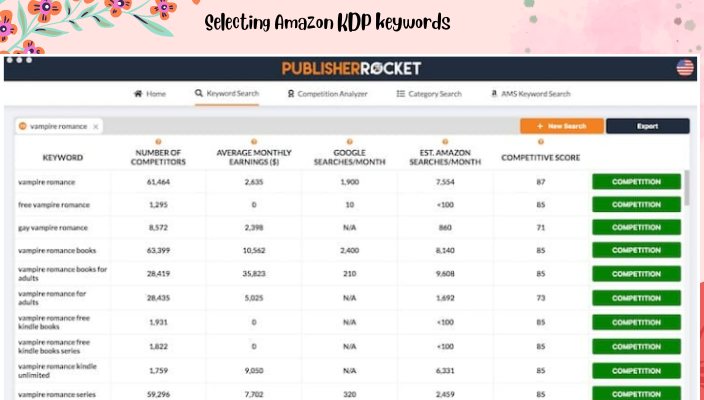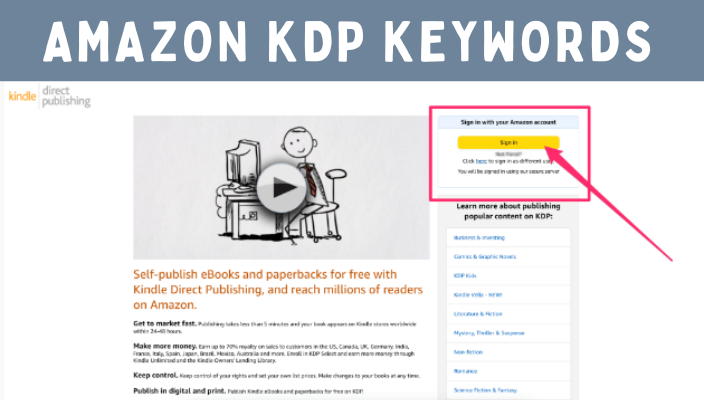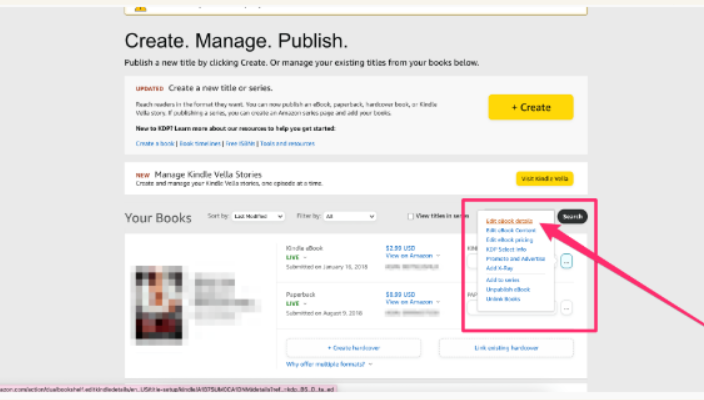Amazon KDP guide, Uncategorized
How to Use Amazon KDP keyword Research: Step-By-Step Guide
As an aspiring writer, are you keen to begin selling books online? A publisher is the only thing keeping you from success. Fortunately, you may avoid that obstacle today! Using Amazon KDP, authors and adventurous booksellers can self-publish quite quickly.
Every Amazon KDP author needs a guide to choosing the best keywords for their advertisements because it’s simple to publish a book but more challenging to get people to read.
This guide includes the most current best practices and accessible methods for conducting amazon KDP keyword research (we also feature more sophisticated commercial tools!).
What are KDP keywords on Amazon?
Use of keywords by search engines. The objectives of a website, web page, product, or in the case of authors, a book are what Google, Bing, and Amazon are interested in learning about.
It is similar to a blog article, which is why keywords are important for optimizing your product, which is your book.
Each of these search engines swiftly evaluates a web page using similar kinds of algorithms.
An algorithm doesn’t read the entire text like a human during the brief inspection of a web page in a few microseconds.
Methods for selecting Amazon KDP keywords
Long-tail keywords are required for authors’ Amazon KDP keywords. What do long-tail keywords entail?
Long-tail keywords are short phrases because they contain many words.
This is a common misconception among authors when choosing Amazon book keywords. Never assume that a book’s Amazon keyword should be a single word. It is not the case.
Your seven Amazon KDP keywords, also known as backend keywords, should each contain several terms.
If you choose Kindle keywords that are only one word, the competition will be fierce. As a result, they will give your book a low rating.
Consider the language used by sellers in the shoe industry. Shoes would be a useless keyword.
Children’s sports, men’s summer, or Italian leather shoes would be preferable options.
On the Kindle Store, Amazon customers seldom search with only one phrase.
Therefore, your goal is to identify brief word groups that will draw readers to your book. Of course, long-tail, multi-word, or semantic keywords will help you succeed much more.
The phrase will have a smaller search volume or user base than a one-word term. But there will also be significantly less keyword competition.
This will increase the likelihood that people searching for new books on Amazon will find your book’s title in a product listing.
Methods for locating long-tail KDP keywords
You can locate relevant long-tail keywords and ideas using free and paid online SEO tools.
You can utilize a variety of Amazon keyword tools.
However, Publisher Rocket is the most often used KDP keyword tool for locating Amazon keywords and categories.
It is a KDP keyword tool that provides real-time data on the search terms used by Amazon book customers.
The tool also provides the volume of Amazon keyword searches for each term recommendation.
For Amazon PPC ads, you can look for the best categories and keywords, assess your competition, and look for AMS keywords.
Publisher Rocket is the quickest and most effective method for conducting Amazon keyword research. You’ll find a lengthy list of terms associated with novels in your genre.
You may obtain the top seven Kindle keywords for your books and your two categories by using this Amazon KDP keyword generator. Of course, you need both to be successful.
You can use the free Amazon book description generator even if you don’t have Publisher Rocket.
Do you already have a lot of books published on Amazon?
You can think about utilizing the free KDP Wizard program to manage and update your data and keywords across numerous titles.
Tools for free Amazon keyword searches
You can find some valuable Amazon KDP keywords by using free tools to search for keyword ideas on Amazon.
Too many tools exist for a comprehensive list. However, other options are available if you search for a free Amazon KDP keywords tool on Google.
Additionally, Google Trends and the Google Ads keyword planner are great choices.
They all function in a manner comparable to any keyword research tool. They will provide you with keyword phrases once you enter one or two words.
Without even realizing it, you are probably already utilizing one of the top free long-tail keyword search tools.
Benefits of Using Amazon KDP Keywords
It’s probably apparent by now that keywords are powerful. Besides attracting the right readers to your book, it also:
Make your book visible. Keywords ensure that your book can be found in Amazon searches, as shown in the screenshot above.
Work for you, not with you. Good keywords make your job as an indie writer easier. Well-chosen keywords are often ranked higher in search queries by Amazon.
One of the few drawbacks of using KDP keywords is that finding them takes time. Therefore, keywords should be accurate, easy to find, and intentional. The following section goes into more detail about using (and searching for) appropriate keywords.
If you’ve picked your keywords and are ready to add them to your metadata, jump to our step-by-step guide.
How to Use Amazon KDP keyword Research: Step-by-Step Guide
Following your keyword research and selection, it’s time to add them to your metadata on the KDP website. It would help if you considered utilizing your keywords in four places: your description, title, and Amazon keyword boxes.
We believe that the book’s title, subtitle, and description contain keywords, even if Amazon does not explicitly say that it does so. Therefore, inserting your keywords in any of these places, if you can, might be advantageous for your book. Although including a keyword in the title or subtitle of your book can be challenging, especially for fiction writers, most authors should be able to incorporate a few keywords into their book descriptions without too much trouble.
What now about the Amazon keyword boxes that we stated earlier?
Here is how to enter your keywords step-by-step.
Go to the KDP website and log in before adding keywords to your book’s information.
Once you’ve logged in, you may access all of the books listed in your KDP account, whether they’ve been released or not.

Any Kindle book you want to add keywords to can be found by clicking “Edit eBook details” from the ellipses next to it. The same will apply to any updated paperback or hardcover books you have listed on KDP.

Once you’ve gotten to your book’s information, scroll down to “Keywords.” Here, there are seven spaces for your keywords. We advise utilizing them all!

After adding or modifying your keywords, select “Save and continue” at the bottom of your screen. Then, go ahead and publish your new keywords on the last screen.

Note: A previous version of this tutorial recommended using semicolons to separate several keywords within a single box. But as of late, we’ve learned that Amazon advises utilizing just one keyword in each of the seven boxes. I appreciate Dave at Kindlepreneur’s explanation.


DISCOVER OUR FREE BEST SELLING PRODUCTS
Editable Canva Lined Journal: Express Your Thoughts – KDP Template
Lined Pages Journal 120 pages Ready to Upload PDF Commercial Use KDP Template 6×9 8.5×11 5×8 for Notebooks, Diaries, Low Content
Lined Pages Journal 120 pages Ready to Upload PDF Commercial Use KDP Template 6×9 8.5×11 5×8 for Notebooks, Diaries, Low Content
Cute Dogs Coloring Book for Kids | Activity Book | KDP Ready-To-Upload
Daily Planner Diary : Diary Planners for Everyday Productivity, 120 pages, 6×9 Size | Amazon KDP Interior
Wolf Coloring KDP interior For Adults, Used as Low Content Book, PDF Template Ready To Upload COMMERCIAL Use 8.5×11"
Coloring Animals Head Book for Kids, Perfect for ages 2-4, 4-8 | 8.5×11 PDF
Printable Blank Comic Book Pages PDF : Create Your Own Comics – 3 Available Sizes
Notes KDP interior Ready To Upload, Sizes 8.5×11 6×9 5×8 inch PDF FILE Used as Amazon KDP Paperback Low Content Book, journal, Notebook, Planner, COMMERCIAL Use
Black Lined Journal: 120 Pages of Black Lined Paper Perfect for Journaling, KDP Notebook Template – 6×9
Student Planner Journal 120 pages Ready to Upload PDF Commercial Use KDP Template 6×9" 8.5×11" for Low Content book
Recipe Journal Template – Editable Recipe Book Template, 120 Pages – Amazon KDP Interior